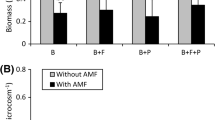Abstract.
The arbuscular mycorrhizal status of two plant species, Biscutella laevigata L. and Plantago lanceolata L., was investigated on calamine spoil mounds in Bolesław (southern Poland). Although B. laevigata is a member of the Brassicaceae, a family generally accepted as non-mycorrhizal, this species formed AM symbioses on both heavy metal-contaminated and non-contaminated sites. Besides vesicles and coils, arbuscules were also observed, especially in roots collected prior to seed maturity. Relative mycorrhizal root length and relative arbuscular richness were usually much higher in P. lanceolata than in B. laevigata but not absolute arbuscule richness. Roots of P. lanceolata showed higher colonisation than B. laevigata. Although roots were collected from plants in close proximity, no correlation in mycorrhizal parameters was found between the two species.
Similar content being viewed by others
Author information
Authors and Affiliations
Additional information
Electronic Publication
Rights and permissions
About this article
Cite this article
Orłowska, .E., Zubek, .S., Jurkiewicz, .A. et al. Influence of restoration on arbuscular mycorrhiza of Biscutella laevigata L. (Brassicaceae) and Plantago lanceolata L. (Plantaginaceae) from calamine spoil mounds. Mycorrhiza 12, 153–159 (2002). https://doi.org/10.1007/s00572-001-0155-4
Accepted:
Issue Date:
DOI: https://doi.org/10.1007/s00572-001-0155-4




